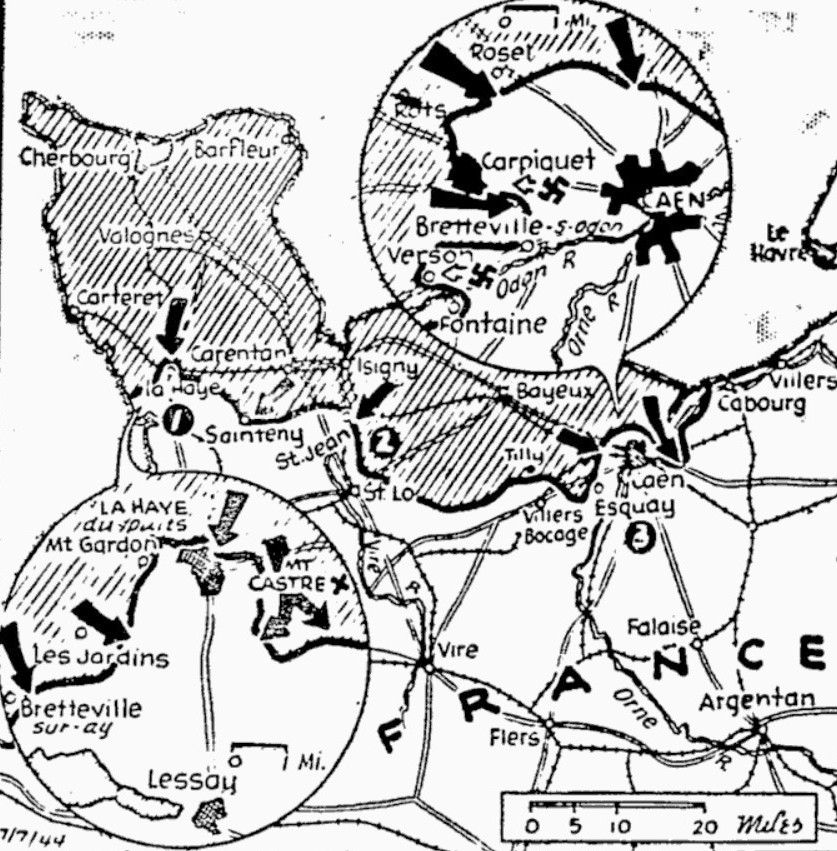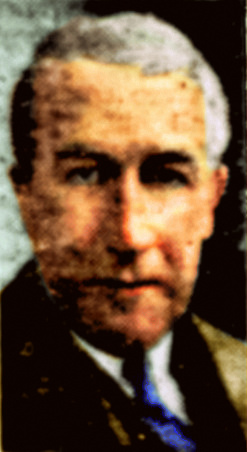Innsbrucker Nachrichten (July 7, 1944)
Ein Kreuzer und sechs vollbeladene Transporter versenkt
Alle Feindangriffe in der Normandie und in Italien abgewiesen – Weiter schweres Vergeltungsfeuer auf London
dnb. Aus dem Führerhauptquartier, 7. Juli –
Das Oberkommando der Wehrmacht gibt bekannt:
Im normannischen Landekopf lag der Schwerpunkt der Kämpfe gestern wieder im Raum südwestlich Carentan bis zur Westküste der Halbinsel Cherbourg. In dem unübersichtlichen Wald- und Buschgelände kam es oft zu erbitterten Nahkämpfen, in denen unsere Truppen alle feindlichen Angriffe, die durch starke Luftangriffe unterstützt waren, abweisen konnten. Bei Le Plessis und südlich Montgardon wurde der eingebrochene Gegner im Gegenstoß geworfen. Die Säuberung des Waldgeländes östlich La Haye-du-Puits von dem dort eingedrungenen Feind ist noch im Gange.
Im französischen Raum wurden 157 Terroristen und mit Fallschirm abgesetzte britische Sabotagetrupps im Kampf niedergemacht.
Über dem Landekopf und den besetzten Westgebieten wurden 22 feindliche Flugzeuge zum Absturz gebracht.
Durch Kampfmittel der Kriegsmarine wurden im Seegebiet der Invasionsfront erneut ein Kreuzer, drei Zerstörer und sechs beladene Transporter mit 32.000 BRT versenkt und ein weiterer Kreuzer schwer beschädigt.
Nördlich der Seinebucht versenkten Sicherungsfahrzeuge in der letzten Nacht ein britisches Artillerieschnellboot und beschädigten mehrere andere.
Im Seegebiet von Brest kam es in der Nacht zum 6. Juli zum Gefecht zwischen vier deutschen Vorpostenbooten und vier feindlichen Zerstörern. Zwei Zerstörer wurden in Brand geschossen. Ein eigenes Boot ging nach heldenhaftem Kampf verloren. Teile seiner Besatzung wurden gerettet.
Schweres Vergeltungsfeuer liegt weiter auf dem Raum von London.
In Italien griff der Feind gestern, von zahlreichen Panzern unterstützt, fast auf der gesamten Front an. Nach harten Kämpfen an der ligurischen Küste, bei Volterra, nordwestlich Siena, im Raum von Arezzo, beiderseits Umbertide und an der Adriaküste wurde der Gegner bis auf geringe örtliche Einbrüche verlustreich abgewiesen. An der adriatischen Küste sind die Kämpfe noch im Gange.
Nachtschlachtflugzeuge griffen in der letzten Nacht wieder den feindlichen Nachschubverkehr an der adriatischen Küste mit guter Wirkung an.
In den Kämpfen der vergangenen Wochen hat sich eine Flakbrigade unter Oberst Müller im Erdkampf besonders ausgezeichnet. Im Süden der Ostfront führte der Feind zwischen dem oberen Dnjestr und Kowel mehrere vergebliche Angriffe. Im Mittelabschnitt dauern die schweren Kämpfe an den bisherigen Brennpunkten der großen Abwehrschlacht an. An der Landenge von Baranowicze wurden feindliche, von Panzern unterstützte Angriffe östlich der Stadt aufgefangen. Auch im Raum westlich Molodeczno wird erbittert gekämpft. Nördlich davon sind feindliche Angriffsgruppen im Vorgehen auf Wilna. Nordwestlich des Naroczsees, wo zahlreiche Angriffe der Sowjets scheiterten, hat sich die bayerische 212. Infanteriedivision unter Führung von Generalleutnant Sensfuß besonders bewährt.
Nördlich und nordwestlich Polozk führten die Bolschewisten gestern nur schwächere Angriffe, die vor unseren Stellungen zusammenbrachen.
Schlachtfliegerverbände griffen wirksam in die Erdkämpfe ein und zersprengten zahlreiche feindliche Kolonnen.
Schwere Kampfflugzeuge setzten den Kampf gegen den sowjetischen Nachschub bei Nacht durch Angriffe auf Bahnhöfe und Eisenbahnlinien mit guter Wirkung fort.
Nordamerikanische Bomber führten gestern einen Terrorangriff gegen die Stadt Kiel.
In der Nacht warfen einzelne britische Flugzeuge Bomben im rheinisch-westfälischen Gebiet. Außerdem griff ein schwacher feindlicher Bomberverband den Raum von Wien an. Durch Nachtjäger wurden zwölf feindliche Flugzeuge abgeschossen.


